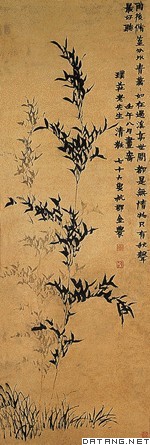1) literati painting


文人画
1.
Impact of "literati painting" on the artistic ideology of Chinese classical garden design;
文人画对中国古典园林设计艺术思想的影响
2.
The Reconstruction of the Oil Painting Language under the Influence of Literati Painting Aesthetical Characteristics;
文人画审美品格影响下的油画语言重建
2) scholar painting


文人画
1.
The Essence and the Contemporary Meaning of Scholar Painting;


文人画的本质及其当代意义
2.
The scholar painting is defined on the basis of the composing idea and aesthetic appeal,not on the form of expressin,of the painting.
文人画是指创作思想和审美情趣而言 ,并不是指在表现形式上属于水墨还是工笔。
3) Literati paintings


文人画
1.
Experimental Plot of Literati Paintings──on the Bamboo & Stone Paintings in Yuan Dynasty;


文人画的试验田──论元人竹石一科
2.
The Flourish of Literati Paintings in the Middle and Late Ming Dynasty;


文人画在明代中后期的缘起
3.
In China,after Song Dynasty,the Literati paintings have been predominant over since Song Dynasty(960-1279).
中国画自宋代以后,文人画一直占统治地位。
4) literary painting


文人画
1.
The literary painting, in creating the mood of a work of art, prominently shows the integrity of the poetic mood and painting mood.
文人画在意境的营造上,突出地表现为诗境和画境的融合。
2.
He made a brand - new breakthrough during the development of our country s literary painting in the Ming dynasty.
他的绘画艺术是我国文人画发展到明代的一个新的突破。
3.
"pop art" scan the history of the literary painting again, probe intoConfucianism.


本文以艺术社会学为方法论,借鉴潘诺夫斯基和里格尔的“艺术意志”和豪泽尔的“精英艺术”、“通俗艺术”等观念来重新梳理文人画发展史,探讨在不同历史阶段儒、道、佛三教对文人画形成与发展所构成的潜在影响,并促使其从萌芽期走入文化内涵定型期、笔墨形式大发展期以至最后的集成期,在这四个时期中又分别孕育出四位文人画家来转变、带动文人画的前进,使“气韵”、“意气”、“笔墨”等范畴趋于成熟定型。
5) scholars paintings


文人画
1.
Chinese traditional scholars paintings are unique in Chinese arts history,and thus comprehending these paintings are of great importance,This paper mainly illustrates forming and developing,main arts feature, and historical influence of these paintings.
中国传统文人画是中国艺术史上极为独特的景观。
2.
It plays an active role in scholars paintings.


气韵生动为中国画“六法”之首 ,对文人画产生了积极的影响。
3.
Calligraphy into paintings has pros and cons in the full development of scholars paintings.
引书入画对文人画的成熟发展有利有弊。
补充资料:文人画
| 文人画 中国传统绘画的风格流派。集文学、书法、绘画、篆刻为一体的综合性绘画艺术。文人画的某些创作思想和艺术追求早在魏晋南北朝时即已出现,至北宋又有文同、苏轼、米芾等人从创作实践到理论上为文人画张目,但作为一个正式名称,却是由明末画家董其昌提出的,他说:“文人之画,自王右丞(王维)始……”,同时又勾划出了一条文人画发展的脉络。近代画家陈师曾对文人画的特质作了理论上的规范,他说:“文人画之要素,第一人品,第二学问,第三才情,第四思想,具此四者,乃能完善。”作为中国画的一个风格流派,文人画在创作思想上,强调抒发画家个人的思想感情,以某些特定的题材,如梅、兰、竹、菊等具有高洁、不俗等象征意义,来表现并标榜个人的志趣、节操、情致;部分画家创作上强调“自娱”,将绘画视为调节精神、情绪的手段。在表现手法上,文人画讲究诗、书(书法)、画、印(篆刻印章)的综合运营,尤注重与书法的结合,主张以书入画,将书法艺术的创作规律及点、画运作融入绘画中,做到心手相应,气力相合,笔断气连,笔不周而意周。在对墨和色彩的选择上,更重视水墨的表现力,讲求墨分五色,通过墨的浓淡干湿的不同变化,描绘不同的物象,抒发不同的情感和心绪。文人画在题材上比较狭窄,虽然历代的文人画家在创作中涉猎过各种题材,但总体上看,大多数文人画家的题材范围局限在山水、花鸟及梅兰竹菊(即所谓的四君子)等带有某种象征意义和寄托性的传统题材上。其作品的思想内容从表面上看,也大都脱离社会现实,但他们通过在画中题写诗文跋语,曲折地表达了个人的思想情感和对社会、人生及艺术的认识。如徐渭在《墨葡萄图》上题诗,表露个人的怀才不遇;郑板桥以题诗的方式,将潇潇的竹声比作民间的疾苦声,凡此等等,皆深化了作品的主题。作为一种风格流派,文人画自登上画坛后,经历代画家们的努力,逐渐发展成熟,到明清时期已成为画坛的主流。文人画的创作思 想、艺术观念及表现手法,对于现代的中国画创作仍具有一定的意义。
|
说明:补充资料仅用于学习参考,请勿用于其它任何用途。
参考词条
